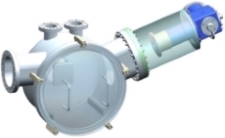The advantage of in-vacuum undulators (IVU), where the magnetic structure is incorporated into the vacuum chamber instead of being situated around it, is that they allow for smaller gaps and, thus, higher magnetic fields and shorter period lengths. However, with the magnets closer to the beam, the risk of radiation damage to the magnets is much higher. In order to circumvent this risk, a high remanence NdFeB magnet material is chosen. The coercivity of this material at room temperature is rather low but can be significantly improved when cooled to 150 K. Cryogenically cooled permanent magnet undulators (CPMUs) are used in many facilities around the world and are currently in the development stage for PETRA IV.
For testing the pole tuning and magnet clamping mechanism under cryogenic temperatures, a small vacuum-chamber with a cryocooler is being prepared (see figure 1). We will investigate the mechanical stability of the entire keeper setup, the impact of thermal cycling on the reproducibility, as well as estimate the thermal budget, which will be required for the operation of an entire undulator system.
Magnetic measurements and tuning for IVUs and CPMUs is often done without the main vacuum vessel installed under ambient conditions and with a conventional measurement set-up using a stable and rigid granite bench. However, especially for CPMUs, which will be operated at cryogenic temperatures, extrapolation of the final cryogenic magnetic performance from these measurements done under ambient conditions is sometimes unreliable. Therefore, a compact Hall-probe measurement system, that fits into the CPMU’s vacuum vessel and which is vacuum compatible, is required. We are, therefore, building a vacuum compatible Hall-probe measurement system based on the SAFALI-system proposed by T. Tanaka et al.
Contact: A. Schöps, M. Trunk
Publications:
Abenhaim, J.; Bolat, H.; Schöps, A.; Vagin, P.; Tischer, M.: J. Phys.: Conf. Ser. 2380 012016 (2022)
Tanaka T et al., Proceedings of FEL 2007 (Novosibirsk, Russia, 2007), WEPPH052, 468–71
Further information (external link):
https://www.esrf.fr/UsersAndScience/Publications/Highlights/2007/XRS/XRS7

Loading menu, please wait..
Deutsches Elektronen-Synchrotron DESY
A Research Centre of the Helmholtz Association
✖

Loading menu, please wait..

Loading menu, please wait..





